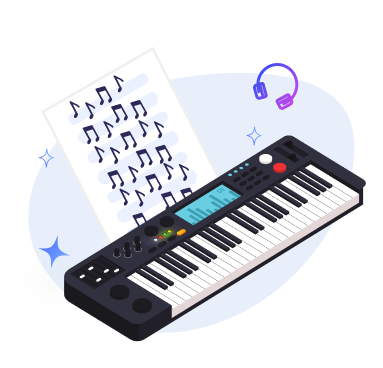
Breaking Down the Beat: Most Popular Rhythms in Music Making
Music is an art form that speaks to the soul, and one of its most fundamental elements is rhythm.
Rhythm is all about creating a repeating pattern of notes over time, and the beat is like the heartbeat of the music.
In this article, we'll explore the popular rhythms in modern music and how they shape the sounds and styles we love. Read on to discover the rhythms that have kept us dancing for generations.
This is Chapter 5 in the
How to Make a Song Guide
Four on the Floor (4/4 time)
The most popular rhythm in music is 4/4 time. This is the classic pop beat and is often referred to as common time. This rhythm is used in many popular songs, from “Happy” by Pharrell Williams to “All Star” by Smash Mouth.
4/4 time is often used in upbeat and catchy songs, as it has a steady and consistent pulse that’s easy to dance and sing along to.
In 4/4 time, the drum pattern usually features a strong emphasis on the downbeat (the first beat of each measure), with the bass drum played on beats 1 and 3 and the snare drum on beats 2 and 4.

Waltz (3/4 time)
A third popular rhythm is 3/4 time, also known as waltz time. This rhythm is used in a variety of genres, from classical music to jazz and pop. It has a gentle, swaying feel that can create a dreamy and romantic atmosphere.
Songs like “Clair de Lune” by Claude Debussy and “Can’t Help Falling in Love” by Elvis Presley are great examples of 3/4 time.
In 3/4 time, the drum pattern often emphasizes the first beat of each measure, with the bass drum played on beat 1 and the snare drum on beat 3.


Latin Rhythm (6/8 time)
Another popular rhythm is 6/8 time. This time signature is often used in pop, rock, and country music. It has a bouncy, upbeat feel that can be great for writing catchy choruses and bridges.
Songs like “Shape of You” by Ed Sheeran and “American Pie” by Don McLean are great examples of 6/8 time.
In 6/8 time, the drum pattern often features a strong emphasis on the first beat of each measure, with the bass drum played on beats 1 and 4 and the snare drum on beat 3. This creates a swinging feel that is commonly heard in Latin and African styles of music.

Reggae Rhythm
The drum pattern for reggae often features a syncopated rhythm that emphasizes the offbeat, with a strong emphasis on the second and fourth beats.
The bass drum is played on the third beat, while the snare drum is played on the second and fourth beats.

Hip Hop Rhythm
The drum pattern for hip-hop is often characterized by a steady, driving beat with a strong emphasis on the downbeat. The bass drum is typically played on beats 1 and 3, while the snare drum is played on beats 2 and 4.

Cut Time (2/4 time)
Finally, there is the 2/4 time signature. This rhythm is often used in marching bands and military music. It has a strong, driving beat that can be great for creating an anthemic and heroic feel.
Songs like “The Final Countdown” by Europe and “We Will Rock You” by Queen are great examples of 2/4 time.

Understanding and utilizing popular rhythms in your songwriting can be a great way to make your music more memorable and enjoyable.
Whether you’re writing a pop song or a classical piece, learning about the most popular rhythms in music and how to incorporate them into your songs can help you create something truly special.

How to Write a Melody for Your Song



